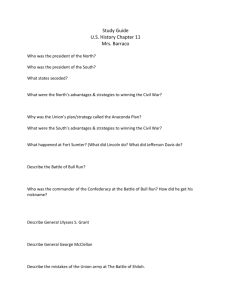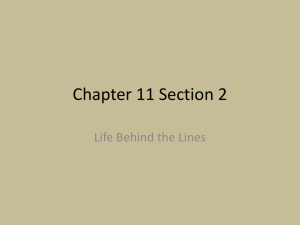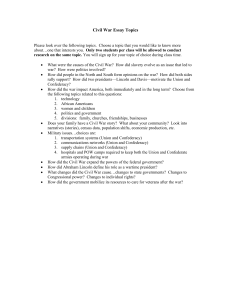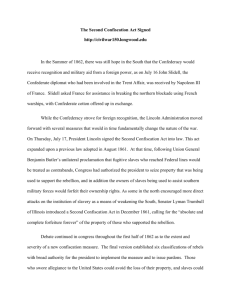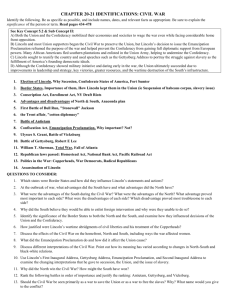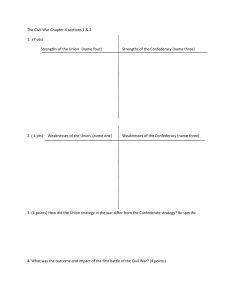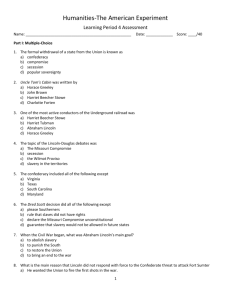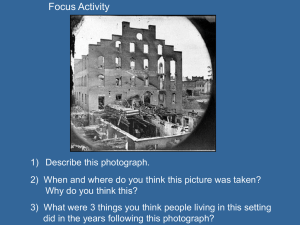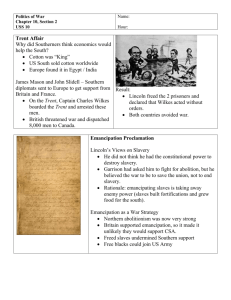NOTES ch 17 (doc) - Monmouth Regional High School
advertisement
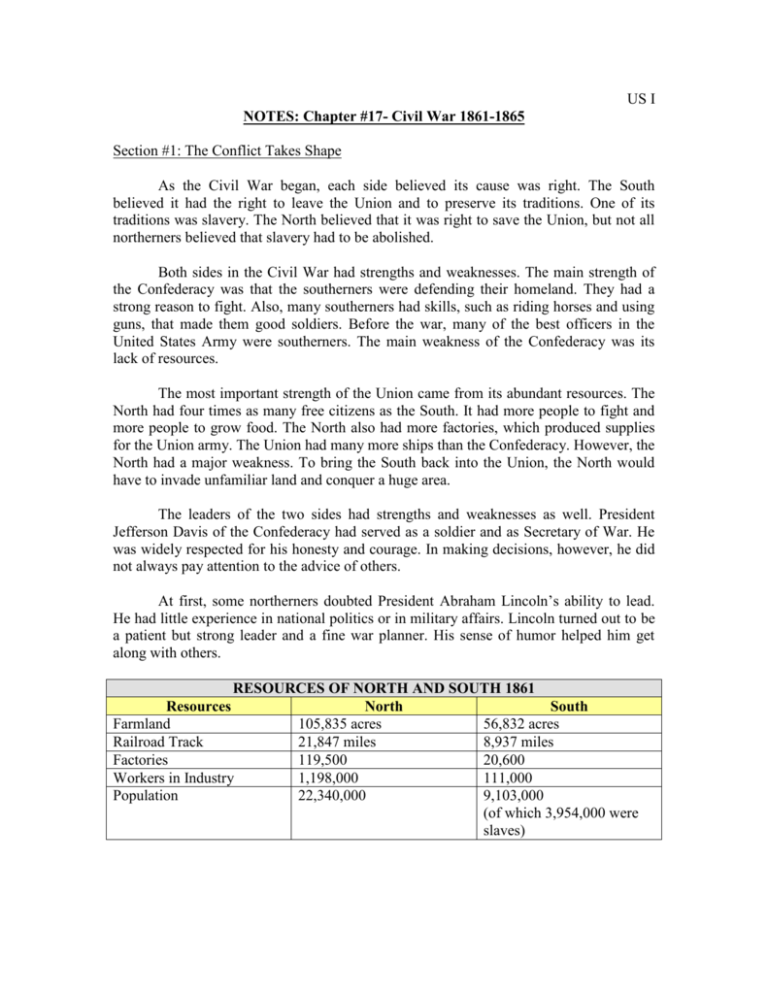
US I NOTES: Chapter #17- Civil War 1861-1865 Section #1: The Conflict Takes Shape As the Civil War began, each side believed its cause was right. The South believed it had the right to leave the Union and to preserve its traditions. One of its traditions was slavery. The North believed that it was right to save the Union, but not all northerners believed that slavery had to be abolished. Both sides in the Civil War had strengths and weaknesses. The main strength of the Confederacy was that the southerners were defending their homeland. They had a strong reason to fight. Also, many southerners had skills, such as riding horses and using guns, that made them good soldiers. Before the war, many of the best officers in the United States Army were southerners. The main weakness of the Confederacy was its lack of resources. The most important strength of the Union came from its abundant resources. The North had four times as many free citizens as the South. It had more people to fight and more people to grow food. The North also had more factories, which produced supplies for the Union army. The Union had many more ships than the Confederacy. However, the North had a major weakness. To bring the South back into the Union, the North would have to invade unfamiliar land and conquer a huge area. The leaders of the two sides had strengths and weaknesses as well. President Jefferson Davis of the Confederacy had served as a soldier and as Secretary of War. He was widely respected for his honesty and courage. In making decisions, however, he did not always pay attention to the advice of others. At first, some northerners doubted President Abraham Lincoln’s ability to lead. He had little experience in national politics or in military affairs. Lincoln turned out to be a patient but strong leader and a fine war planner. His sense of humor helped him get along with others. RESOURCES OF NORTH AND SOUTH 1861 Resources North South Farmland 105,835 acres 56,832 acres Railroad Track 21,847 miles 8,937 miles Factories 119,500 20,600 Workers in Industry 1,198,000 111,000 Population 22,340,000 9,103,000 (of which 3,954,000 were slaves) Section #2: No Easy Victory The North and the South had different plans for the war. Southerners planned to fight a defensive war. They would wait for northern armies to attack and then drive them back north. The Confederates believed that they could fight off the Union until northerners tired of fighting. When the war became unpopular, the North would be forced to accept the Confederacy. The North had a three-part plan. First, it would use ships to blockade southern ports and prevent supplies from entering the South. Second, the Union hoped to quickly capture Richmond, Virginia, the Confederate capital. Third, the Union planned to seize control of the Mississippi River. This would cut the Confederacy into two parts and prevent the movement of southern troops and supplies along the river. The North soon was more successful in two parts of its war plan. The Union navy was able to blockade southern ports. Trade to the South dropped by more than 90%. The navy also moved to gain control of the Mississippi River. Union gunboats captured New Orleans, and more ships seized Memphis, Tennessee. The Union now controlled both ends of the Mississippi. At the same time, Union General Ulysses S. Grant led his army to victory during the Battle of Shiloh on the Tennessee River. The North was slowly gaining control of the western part of the Confederacy. In the east, however, Union armies did not win any major battles in the first years of the war. The Battle of Bull Run was the first of the war. Neither side could claim a victory. The battle did show, however, that the war would be long and difficult. The naval battle between the Confederate ship Virginia and the Union ship Monitor also ended in a draw. The Union was not able to capture Richmond as it had hoped. The Confederates won the Battle of Fredericksburg- one of the Union army’s worst defeats in Virginia- and the Battle of Chancellorsville, but at great cost. The South’s best general, Stonewall Jackson, was killed at Chancellorsville. WHAT WERE THE PLANS OF EACH SIDE? North South Blockade southern ports Fight a defensive war until northerners tire of fighting Take Richmond, Virginia, the Confederate capital Depend on European money and supplies Seize control of the Mississippi River to cut the Confederacy in two Section #3: A Promise of Freedom KEY TERMS: Emancipation- set free On January 1, 1863, President Lincoln issued the Emancipation Proclamation. His goal was to emancipate all slaves in the Confederate states. Lincoln believed that the Union could be saved by broadening the goals of the war. The goals were not to restore the Union and free slaves. However, the Emancipation Proclamation did not free all slaves. In the Union, and in Confederate lands controlled by the Union, slaves were not freed. Lincoln wanted to introduce freedom for slaves gradually. He was not sure that northerners would support freedom for all slaves. Because the rebelling states were not under Union control, no slaves actually gained freedom on January 1, 1863. However, the Emancipation Proclamation had important effects. First, Union troops were now fighting to end slavery as well as to save the Union. Also, the Emancipation Proclamation won the Union sympathy from European countries. It became less likely that the countries would help the South. And it made both free and enslaved African Americans enthusiastic supporters of the North. African Americans contributed a great deal to the Union war effort. At first, black troops faced discrimination. However, by the end of the war, large numbers of African Americans- about 200,000- had fought for the Union. The most famous African American unit, the 54th Massachusetts Regiment, fought bravely at Fort Wagner, near Charleston, South Carolina. Behind Confederate lines, slaves did what they could to weaken the southern war effort. Emancipation Proclamation WHAT? It states that all slaves are free in Confederate areas still fighting the Union. WHY? EFFECTS? Lincoln hopes to weaken the South and introduce freedom for slaves gradually. Union troops fight to end slavery as well as save the Union. Union wins sympathy from countries in Europe. Section #4: Hardships of the War KEY TERMS: Draft- selection for required service in the military Inflation- rise in prices Income Tax- tax on earnings Life for soldiers during the Civil War was difficult. They slept on the ground in rain and snow. New weapons made fighting even more deadly. In most battles, ¼ or more of the soldiers were killed or wounded. Because of poor medical care, many soldiers died of infections and diseases. If captured, they faced terrible conditions in prison camps. Both sides faced difficult problems home. In the North, many people, called Copperheads, opposed the war. Fewer men volunteered to fight, so Congress passed a draft law. This law led to violent riots in several cities. The North and the South also faced economic problems. Both regions experienced inflation. In order to pay for the war, both sides began an income tax. Profiteers charged high prices for needed supplies. However, the economic problems were much more difficult in the South than in the North. The war stopped the cotton trade, the most important part of the southern economy. The northern blockade also created severe shortages of food in the South. In both the North and the South, women played a key role. Many women served as nurses, improving medical care. Some women were soldiers and spies. At home, women raised money and collected supplies, including food. As men left for the battlefields, women even took jobs in industry and on farms. Loreta Janeta Velasquez Rose Greenhow Dorothea Dix Clara Barton Sojourner Truth Sally Tompkins WOMEN IN THE CIVIL WAR Fought for South at Bull Run and Shiloh Spied for South in Washington, D.C. Served as chief of nurses for Union Served as nurse and founder of Red Cross Worked in Union hospitals and camps for freed slaves Opened a hospital in Richmond, Virginia Section #5: The War Ends KEY TERMS Total War- war in which troops destroy food and equipment useful to an enemy In July 1863, the North won two key battles. Union forces took the town of Vicksburg on the Mississippi River. The Union soon controlled the entire rive. Another major northern victory was the Battle of Gettysburg in Pennsylvania. Pickett’s Charge was the Confederates’ last attempt to invade the North. If the Confederates had defeated the Union in Pennsylvania, they could have marched on Washington, D.C. However, the Confederates would never invade the North again. At a ceremony after the battle, President Lincoln gave the Gettysburg Address. In this speech, Lincoln reminded people that the United States was founded on the belief that “all men are created equal.” The Union was fighting, he said, so that “government of the people, by the people, and for the people, shall not perish from the Earth.” This short but famous speech has been honored as an important statement of American ideals. The North finally defeated the South through a strategy of total war. General Ulysses S. Grant, the commander of Union forces in 1864, wanted to destroy the South’s ability to fight. He sent General William Tecumseh Sherman to attack Atlanta and march from here to the sea. Union troops burned farms, houses, and cities along the way. In 1865, General Lee surrendered the main southern army at Appomattox Courthouse. After four long and terrible years, the Civil War was over. Lincoln nearly lost reelection in 1864 because of the war. Sherman’s success, however, helped him keep the Presidency. He knew that the next four years would be difficult. He hoped to rebuild the Union. The war had taken a terrible toll on the nation, yet it was an important turning point. The national government became more powerful than state governments. Slavery ended, and millions of African Americans became free citizens. In the end, the war unified the nation. CAUSES: South fears loss of power in the national government. Issue of slavery in the western territories divides North and South THE CIVIL WAR EFFECTS: Lincoln issues Emancipation Proclamation Total war destroys the South Hundreds of thousands of Americans are killed
